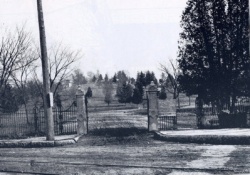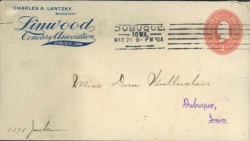Encyclopedia Dubuque
"Encyclopedia Dubuque is the online authority for all things Dubuque, written by the people who know the city best.”
Marshall Cohen—researcher and producer, CNN
Affiliated with the Local History Network of the State Historical Society of Iowa, and the Iowa Museum Association.
LINWOOD CEMETERY
LINWOOD CEMETERY. In 1833 the first cemetery for the city of Dubuque was located in what later became JACKSON PARK. (1) At the time, the site was called the City Cemetery. As a result of the survey of 1836, it was discovered that burials were being made in what would be the right-of-way of Main, 15th, 16th, and Iowa STREETS. (2) The graveyard was surveyed in 1852 with proper lines established and graves in the right-of-ways were removed. (3)
As the community grew, residents in the area did not like the cemetery near their homes and the site was quickly becoming too small. City planners also wished to extend Iowa Street to 17th Street. In 1851 the city condemned the cemetery and would not allow more graves to be dug. (4) In 1851 ten areas in a site called Cherry Hill northeast of the city were purchased. In 1853 another ten acres adjoining the property were given by Lucius Hart LANGWORTHY. (5)
The cemetery at Dubuque consisted of twenty acres, about one-half of which was laid out into lots. It was not well drained, because a circular tract in the middle was lower than the surroundings. It was thought best to buy another 20-acre tract lying immediately west and contiguous to the old yard. (6) It was arranged that 70 per cent of the proceeds of the sale of lots should be paid to the owner of the land, and the other 30 per cent go to the treasury to be used in laying out the ground, fencing it, etc. The cemetery then consisted of forty acres in a regular square, beautifully situated and commanding a view both of the MISSISSIPPI RIVER and the city. The price of the lots was fixed at sums varying from $5 to $25 each. About four acres were set apart for a potter's field. (7) The cemetery, named "Linwood" by the city council, became the first city-owned cemetery in the Midwest. (8)
In April 1865, the process of re-interring sixty graves from Jackson Square began with most of the work done in 1867. (9) Although technically under the care of the City, Linwood was a scene of disorganization. There were no carriage or footpaths and thickets were allowed to grow.
The sad state of affairs at the city cemetery led nineteen prominent citizens to form the Linwood Cemetery Association on August 28, 1875. (10) Shares of stock were sold at $100 each the first year and then on an installment basis of ten dollars per year. (10) According to the articles of incorporation, the investors were to receive 6% on their investment with surplus funds raised from the sale of lots going for maintenance of the property. (11) This group called for a citywide vote in October 1875, to determine whether they should take over the care of the grounds. The City, by a vote of 697 to 308, was removed from the cemetery business. (12)
Using their capital, the Association purchased about 105 acres, including the cemetery, for $8,676. (13) Owners of lots in the old cemetery were asked to give from $15.00 to $20.00 depending upon the care needed for the Association to provide perpetual care to the graves. (14) In 1877, the Association could claim that it spent $30,000 on cleaning up the grounds, building a fence and constructing a mile of macadamized road within the cemetery. (15) Lots cost between ten and thirty cents per square foot which included perpetual care. This was said to be from fifty to seventy-five percent cheaper than in well established cemeteries in other parts of the country. (16)
By 1907 the cemetery grounds expanded to 147 acres, and adult graves (lined in brick) sold for fifteen dollars. Previously graves had been priced by length and were eight to twenty dollars. Grass clipping cost two cents, and water hydrants for the use of the lot owner were available at two dollars.
Originally Linwood was known as the Protestant Cemetery. Today, with over sixty thousand persons buried there, the cemetery serves the needs of all faiths.
Linwood is unique because the city's CIVIL WAR Soldiers' Monument. Dedicated on November 5,1893 after twelve years of fund-raising, the monument stands in the cemetery instead of the town square where most cities placed such an object. Another memorial is the elaborate gateway at the entrance to the cemetery. Dedicated on May 30, 1948, the gateway was constructed through the bequest of Mrs. Augusta Eighteen Clapp in memory of her father, Charles H. EIGHMEY, former president of the FIRST NATIONAL BANK OF DUBUQUE.
The 1970s were a time of increased change for Linwood. As it celebrated its 100th anniversary, Linwood became a member of the National Association of Cemeteries, the governing body of all cemeteries across the United States. It also joined the National Lot Exchange. This allowed people who owned a lot in Linwood to transfer ownership to another cemetery if they moved. Linwood also became a complete service cemetery offering for sale monuments, markers, and benches. In 1976 Linwood revived a formal Memorial Day ceremony--a practice that had been discontinued for unknown reasons forty years ago. (17) Linwood also erected a 100 foot flag pole, donated by the Egelhof-Casper Funeral Home at the entrance to the cemetery.
In 1979 Linwood began its Avenue of Flags consisting of twenty-five flags beginning at the entrance to the cemetery. By 2009 this number had grown to over 700 and they were flown during Memorial Day, Flag Day, and the Fourth of July. (18)
In 2001 the Linwood Cemetery Association began the construction of a mausoleum. The building would contain 240 burial vaults and a columbarium with 112 niches for cremains. (19)
Dubuque history was presented at Linwood through "walks." In 2004 actors and actresses represented four famous Dubuque residents. (20)
Among the estimated fifty thousand people buried in Linwood are John Francis RAGUE, David B. HENDERSON, John Taylor ADAMS, Stephen HEMPSTEAD, George W. HEALEY, William Boyd ALLISON, and Mathias HAM.
---
Source:
1. Kruse, Len. "My Old Dubuque," Dubuque, Iowa: Center for Dubuque History, Loras College, 2000, p. 63
2. Ibid., p. 64
3. Ibid.
4. Ibid.
5. Oldt, Franklin T. History of Dubuque County. http://www.ebooksread.com/authors-eng/franklin-t-oldt/history-of-dubuque-county-iowa-being-a-general-survey-of-dubuque-county-histor-tdl/page-10-history-of-dubuque-county-iowa-being-a-general-survey-of-dubuque-county-histor-tdl.shtml
6. Ibid, p. 17
7. Ibid.
8. Nevans-Pederson, Mary,"Linwood Breaks Ground on Facility," Telegraph Herald, October 5, 2001, p. 3. Online: http://news.google.com/newspapers?id=m41dAAAAIBAJ&sjid=iFwNAAAAIBAJ&pg=5018,566296&dq=linwood+cemetery&hl=en
9. Kruse, Len. p. 64
10. "Linwood Cemetery," Dubuque Herald, June 24, 1877, p. 4. Online: http://news.google.com/newspapers?id=-ZZCAAAAIBAJ&sjid=OasMAAAAIBAJ&pg=2321,5446500&dq=linwood+cemetery&hl=en
11. Kruse, Len. p. 64
12. Ibid.
13. Marner, Lari,"Linwood Cemetery Nears its Centennial Year," Telegraph Herald, October 21, 1974, p. 1. Online: http://news.google.com/newspapers?id=9QVRAAAAIBAJ&sjid=Gr8MAAAAIBAJ&pg=7303,3197166&dq=linwood+cemetery&hl=en
14. "Linwood Cemetery..."
15. Ibid.
16. Ibid.
17. Tighe, Mike. "Formal Memorial Day Service Returns to Linwood Cemetery," May 27, 1976, p. 23. Online: http://news.google.com/newspapers?id=-YNSAAAAIBAJ&sjid=778MAAAAIBAJ&pg=6892,3832899&dq=linwood+cemetery+dubuque&hl=en
18. Norvell, Kim. "Honoring Freedom's Defenders," Telegraph Herald, May 26, 2009, p. 1. Online: http://nl.newsbank.com/nl-search/we/Archives?p_product=DQ&p_theme=dq&p_action=search&p_maxdocs=200&p_topdoc=1&p_text_direct-0=12872CF40E177BA0&p_field_direct-0=document_id&p_perpage=10&p_sort=YMD_date:D&s_trackval=GooglePM
19. Nevans-Pederson, Mary.
20. Hogstrom, Erik. "Ghostly Walk Plans to Retell Much of Dubuque's History," Telegraph Herald, September 24, 2004, p. 7A. Online: http://nl.newsbank.com/nl-search/we/Archives?p_product=DQ&p_theme=dq&p_action=search&p_maxdocs=200&p_topdoc=1&p_text_direct-0=10556BC2952FDA05&p_field_direct-0=document_id&p_perpage=10&p_sort=YMD_date:D&s_trackval=GooglePM





